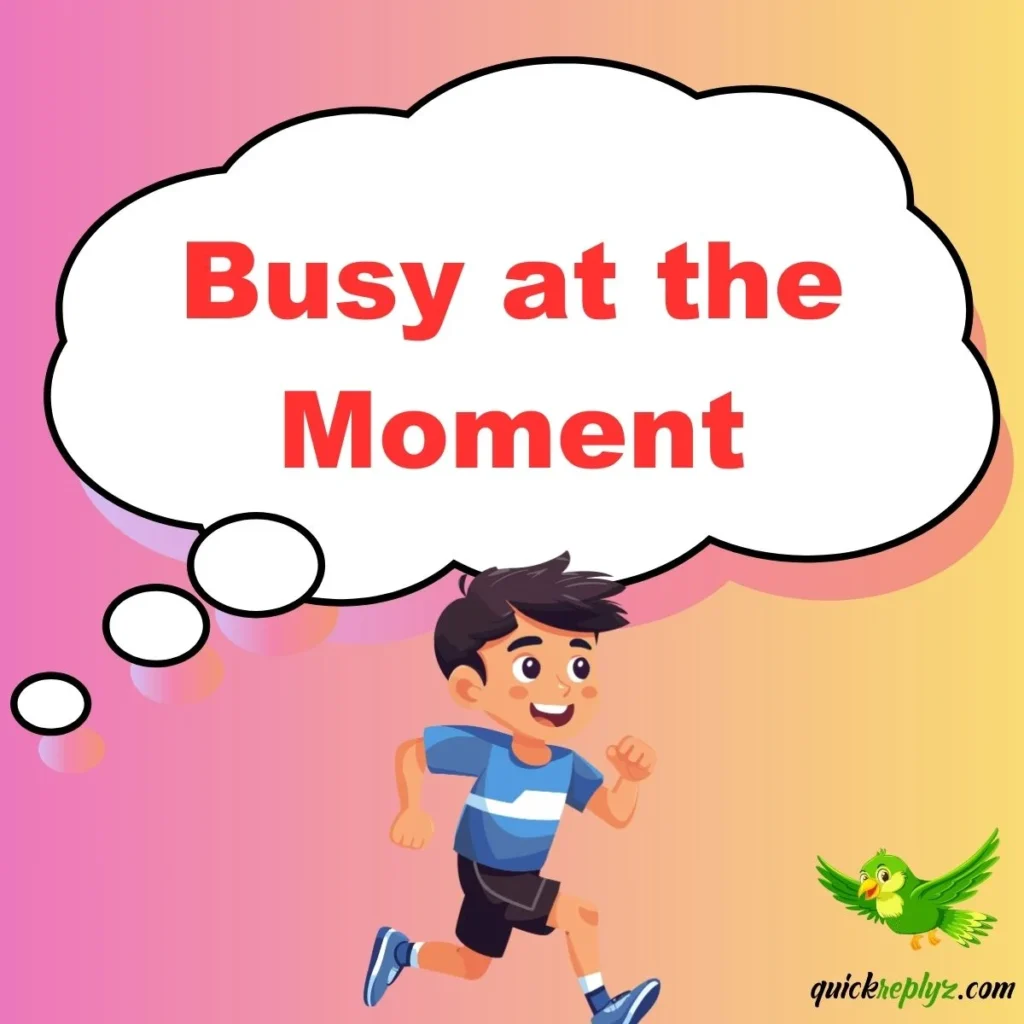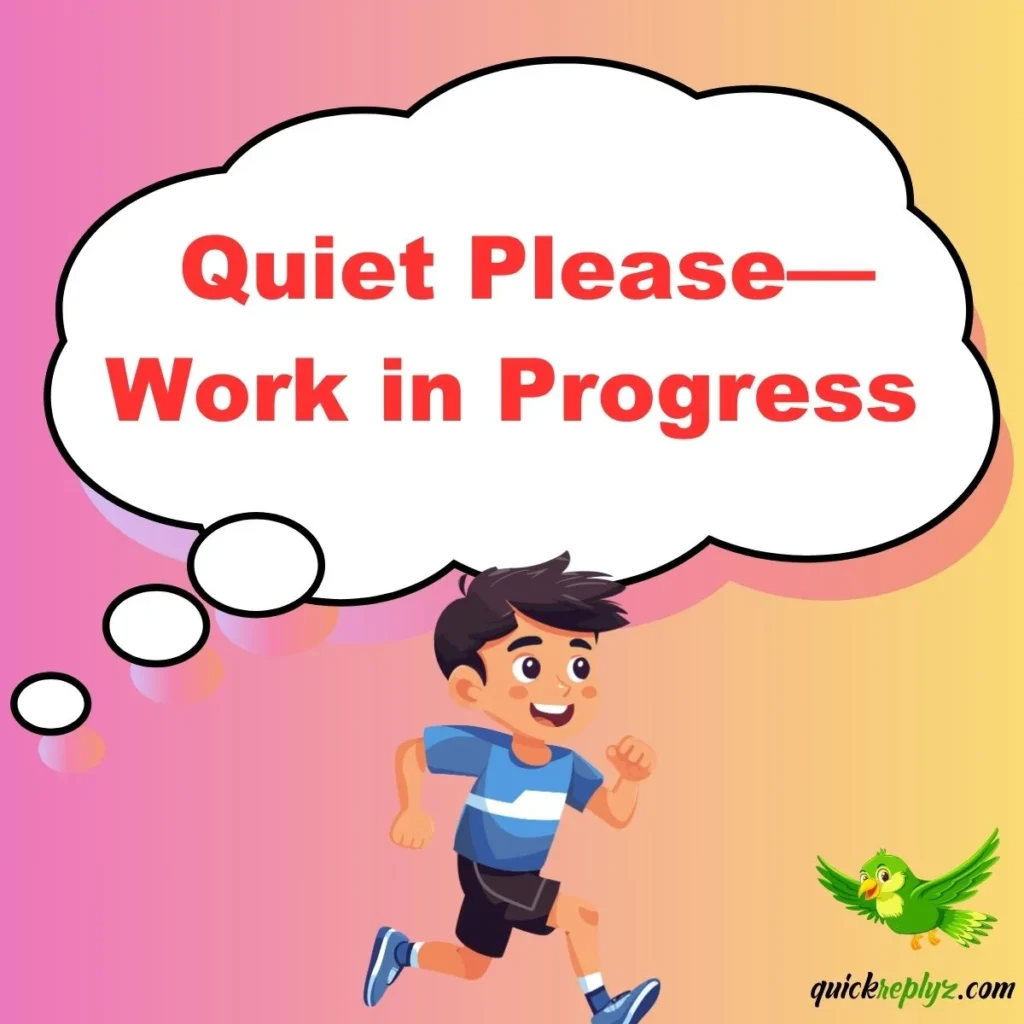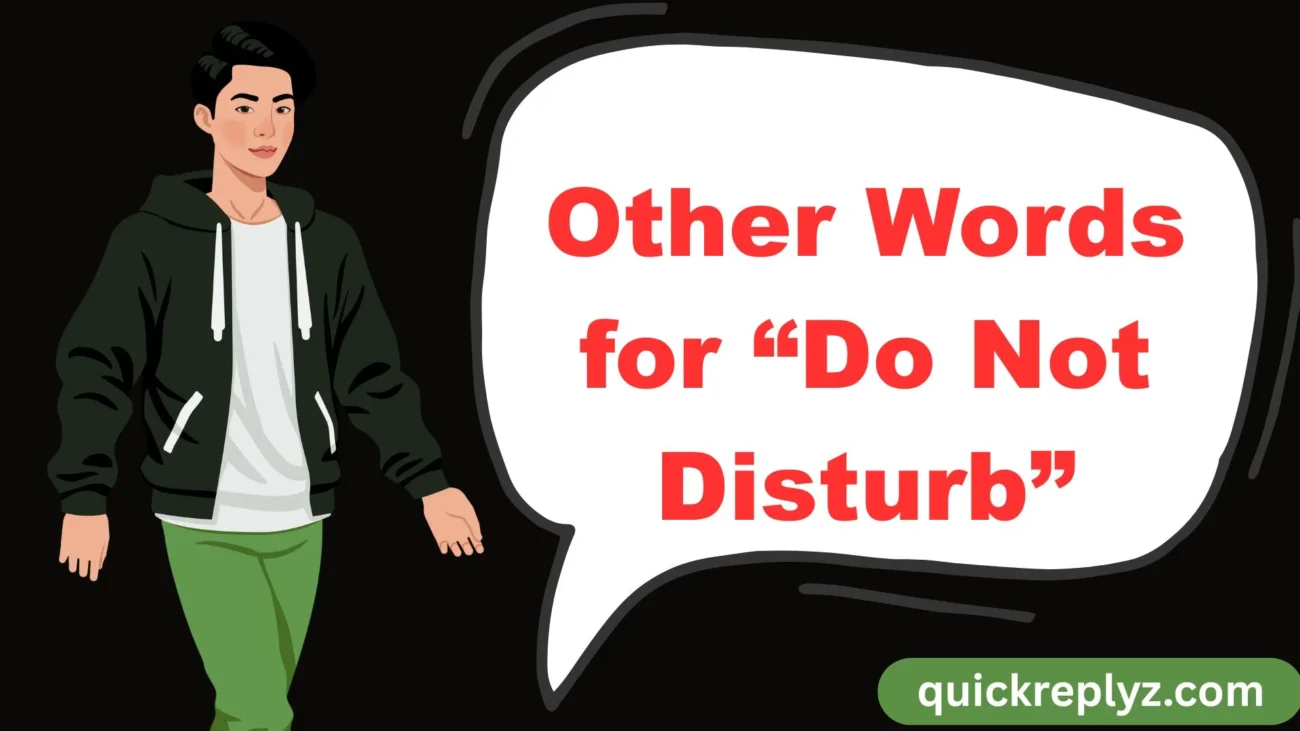In today’s fast-paced world, finding ways to politely ask for privacy or signal unavailability is more important than ever. While the classic phrase “Do Not Disturb” works, there are dozens of creative alternatives that convey the same message with more personality,
politeness, or style. In this guide, we’ll explore 30 other words and phrases for “Do Not Disturb”, each with its own tone, context, and charm.
Whether you’re setting your office status, putting up a sign, or sending a message, these options will help you express boundaries clearly while keeping communication friendly and professional.
Another or professional way to say “In Time of Need”
- Please Respect My Time
- In Deep Work Mode
- Engaged—Please Wait
- Quiet Zone Ahead
- Focus in Progres
- Please Hold All Calls
- Privacy Requested
- Occupied—Please Knock
- Off the Clock
- Busy at the Moment
- Unavailable for Interruptions
- In a Meeting—Please Wait
- Meditation in Progress
- Training Session Underway
- Recording in Progress
- Session in Progress
- Creative Flow Time
- Temporarily Unavailable
- On a Break
- Quiet Please—Work in Progress
- Do Not Enter at This Time
- Resting—Please Do Not Disturb
- In Private Consultation
- Knock Before Entering
- In Session—Silence Appreciated
- Do Not Interrupt—Important Task Ongoing
- Stepping Away Briefly
- Under Maintenance—Access Restricted
- Silence Request
- Please Wait Until I’m Availabl
1. Please Respect My Time
Sometimes, the best alternative is one that’s polite yet firm. “Please Respect My Time” communicates the importance of boundaries without sounding harsh. This phrase works well in professional settings where you want to maintain courtesy while requesting focus.
Example: Sending an email update with, “I’ll be offline for the next two hours—please respect my time while I complete this task.”
Best Use: Office door signs, shared workspace etiquette, and polite email autoresponders.
2. In Deep Work Mode
Perfect for creative professionals or remote workers, “In Deep Work Mode” conveys that you’re in a focused state and interruptions will break your concentration. It sounds modern and tech-friendly, making it a great choice for Slack statuses or Zoom profiles.
Example: Slack status reads, “In deep work mode—available after 3 PM.”
Best Use: Digital workplace environments, coworking spaces, and productivity apps.
3. Engaged—Please Wait
This alternative blends politeness with formality. “Engaged—Please Wait” makes it clear you’re occupied while inviting patience from others. It’s often seen in customer service or reception settings.
Example: A meeting room sign reads, “Engaged—Please Wait Before Entering.”
Best Use: Reception desks, waiting rooms, and meeting spaces.
4. Quiet Zone Ahead
If you want to set a calm tone, “Quiet Zone Ahead” works perfectly. It’s often used in libraries, meditation centers, or even home offices to encourage silence.
Example: A printed sign outside a yoga studio saying, “Quiet Zone Ahead—Please Turn Off Devices.”
Best Use: Wellness spaces, reading rooms, and noise-sensitive areas.
5. Focus in Progress
This phrase tells people you’re in the middle of something important and shouldn’t be interrupted. “Focus in Progress” works great for individual or team productivity.
Example: Post-it note on your monitor: “Focus in Progress—Back in 45 Minutes.”
Best Use: Study sessions, project sprints, and coding marathons.
6. Please Hold All Calls
A classic in offices, “Please Hold All Calls” signals you’re unavailable for phone conversations at the moment. It’s professional and direct.
Example: Receptionist memo: “From 2 PM to 4 PM, please hold all calls for Mr. Khan.”
Best Use: Executive offices, call centers, and legal consultations.
7. Privacy Requested
For situations where you want a softer approach, “Privacy Requested” sounds formal yet gentle. It’s versatile for personal and professional use.
Example: Door sign: “Privacy Requested—Knock Before Entering.”
Best Use: Counseling offices, private meetings, and shared homes.
8. Occupied—Please Knock
Straightforward and clear, “Occupied—Please Knock” works in nearly every setting where entry control is needed.
Example: On a recording studio door: “Occupied—Please Knock if Urgent.”
Best Use: Bathrooms, recording booths, and workshops.
9. Off the Clock
For informal environments, “Off the Clock” is a friendly way to say you’re not working or available.
Example: Social media post: “Off the clock this weekend—replies may be delayed.”
Best Use: Freelancers, personal messages, and break times.
10. Busy at the Moment

“Busy at the Moment” is a polite, everyday way to tell someone you’ll get back to them later.
Example: Text message: “Busy at the moment—can we talk in an hour?”
Best Use: Texts, chats, and quick polite refusals.
11. Unavailable for Interruptions
Sometimes you need to be firm but not unfriendly. “Unavailable for Interruptions” is a clear, professional way to tell others you’re focusing on something critical. This phrase works especially well in team environments where others may be tempted to pop in for quick chats. It also conveys respect for both your own time and theirs, signaling you’ll respond later when you’re free. The tone is formal yet considerate, making it versatile for emails, virtual statuses, or physical signs in the workplace.
Example: Outlook status: “Unavailable for interruptions until 5 PM—urgent issues via email only.”
Best Use: Office hours, corporate communication, and remote work schedules.
12. In a Meeting—Please Wait
A polite way to pause interactions without being abrupt. “In a Meeting—Please Wait” ensures others know you’re not ignoring them, just currently engaged. It’s common in customer service, HR offices, and executive suites where unexpected visitors might arrive. This phrase also works well on digital tools like Teams or Zoom to show you’re actively busy. The courteous “please wait” softens the boundary while keeping it firm.
Example: Door sign: “In a Meeting—Please Wait for the Next Available Staff Member.”
Best Use: Face-to-face appointments, team calls, and official conferences.
13. Meditation in Progress
This alternative is perfect for wellness and mental health settings. “Meditation in Progress” signals that you’re engaging in a quiet, mindful practice that shouldn’t be disturbed. It’s not just about silence—it’s about preserving an atmosphere of calm and focus. Whether used at home, in a yoga class, or in a meditation retreat, this phrase invites respect for the peaceful environment you’re trying to maintain.
Example: Spa sign: “Meditation in Progress—Kindly Keep Voices Low.”
Best Use: Yoga studios, home meditation spaces, and wellness retreats.
14. Training Session Underway
When learning or teaching, distractions can derail the process. “Training Session Underway” lets others know you’re in the middle of structured learning. It’s ideal for workplaces where training is routine but needs a quiet, focused setting. It can also apply to sports coaching, music lessons, or any environment where concentration is key. This phrase carries a sense of professionalism and purpose.
Example: Classroom poster: “Training Session Underway—Please Do Not Enter Without Permission.”
Best Use: Corporate training rooms, classrooms, and skill workshops.
15. Recording in Progress
In the world of content creation, “Recording in Progress” is essential. Whether you’re a podcaster, musician, or videographer, unexpected noise can ruin a take. This phrase is direct, easily understood, and carries authority. It signals to others that they should be mindful of volume and avoid entering the recording area. The professional undertone ensures people take it seriously, even in casual settings.
Example: Studio door sign: “Recording in Progress—Silence Please.”
Best Use: Film sets, audio studios, and livestream sessions.
Also Read This :30 Best Christos Anesti Responses in Greek
16. Session in Progress
Broad and adaptable, “Session in Progress” can refer to therapy sessions, coaching, photography, or business meetings. It’s concise and avoids revealing too much about the nature of the activity while still asking for privacy. The neutral wording makes it a great choice for situations that require discretion and professionalism.
Example: Office door: “Session in Progress—Please Wait in the Lobby.”
Best Use: Counseling rooms, creative workshops, and professional consultations.
17. Creative Flow Time
For artists, writers, and designers, “Creative Flow Time” captures the importance of uninterrupted inspiration. This phrase is warm and personal, making it ideal for informal settings where you still want your boundaries respected. By framing your unavailability as “flow time,” you emphasize productivity in a positive light rather than as simple unavailability.
Example: Social post: “In creative flow time—check back for updates this evening!”
Best Use: Home studios, coworking spaces, and personal creative projects.
18. Temporarily Unavailable
“Temporarily Unavailable” is a neutral, professional, and widely understood phrase. It avoids the harshness of “Do Not Disturb” while still delivering the message. Because it’s so adaptable, it works in both physical spaces and digital communication. It’s polite without being overly casual or formal.
Example: Website notice: “Temporarily unavailable—services will resume at 2 PM.”
Best Use: Customer service desks, live chat statuses, and maintenance notices.
19. On a Break
Short and friendly, “On a Break” is perfect for casual environments. It signals you’re away for a short time but will be back soon. Unlike more formal alternatives, it invites a relaxed understanding without discouraging future interaction.
Example: Shop sign: “On a break—back in 15 minutes.”
Best Use: Cafés, retail stores, and casual workplaces.
20. Quiet Please—Work in Progress

This one combines a polite request with a productivity reminder. “Quiet Please—Work in Progress” works great in environments where multiple people are working on complex tasks. It’s clear, direct, yet courteous.
Example: Open office placard: “Quiet Please—Work in Progress Until Noon.”
Best Use: Design studios, academic labs, and collaborative workspaces.
21. Do Not Enter at This Time
Sometimes, you need a phrase that’s direct and leaves no room for misunderstanding. “Do Not Enter at This Time” is firm but still polite, perfect for situations where privacy is essential and safety might be a concern. It works well for both temporary restrictions and regular use.
Example: Construction site sign: “Do Not Enter at This Time—Authorized Personnel Only.”
Best Use: Restricted areas, private events, and safety-sensitive locations.
22. Resting—Please Do Not Disturb
Ideal for home, hotels, or wellness settings, “Resting—Please Do Not Disturb” adds a human touch to the request. It communicates a need for peace without sounding cold, and it’s particularly effective in hospitality contexts where guest comfort is a priority.
Example: Hotel door hanger: “Resting—Please Do Not Disturb Until 9 AM.”
Best Use: Hospitality, patient rooms, and home rest times.
23. In Private Consultation
This phrase is formal and professional, indicating that sensitive discussions are underway. “In Private Consultation” assures confidentiality and discourages interruptions. It works well in healthcare, legal, and counseling environments where discretion is key.
Example: Lawyer’s office door: “In Private Consultation—Please Wait Outside.”
Best Use: Medical offices, legal consultations, and HR meetings.
24. Knock Before Entering
“Knock Before Entering” is a softer approach that doesn’t completely block entry but ensures people check in first. It’s respectful, non-intimidating, and perfect for shared environments.
Example: Classroom sign: “Knock Before Entering—Class in Session.”
Best Use: Teacher’s offices, dorm rooms, and shared workspaces.
25. In Session—Silence Appreciated
Blending professionalism with courtesy, “In Session—Silence Appreciated” acknowledges ongoing work or activity while kindly requesting quiet. It’s especially effective for activities requiring high concentration or emotional sensitivity.
Example: Therapy room door: “In Session—Silence Appreciated.”
Best Use: Therapy centers, music rehearsals, and exam halls.
26. Do Not Interrupt—Important Task Ongoing
When you’re handling something critical, this phrase leaves no doubt. “Do Not Interrupt—Important Task Ongoing” sets a clear boundary while explaining the urgency. This helps others understand that their interruption might have serious consequences.
Example: Engineering lab note: “Do Not Interrupt—Important Task Ongoing Until Test Completion.”
Best Use: Technical workspaces, research labs, and high-stakes projects.
27. Stepping Away Briefly
Friendly and approachable, “Stepping Away Briefly” suggests you’ll be back soon, making it less final than “Do Not Disturb.” It’s a great choice for customer-facing settings where you want to maintain a welcoming tone.
Example: Retail counter sign: “Stepping Away Briefly—Back at 3:15 PM.”
Best Use: Shops, small offices, and personal workspaces.
28. Under Maintenance—Access Restricted
For facilities or systems that are temporarily out of service, “Under Maintenance—Access Restricted” is both formal and clear. It’s particularly useful when safety or technical issues are involved.
Example: Server room notice: “Under Maintenance—Access Restricted Until 6 PM.”
Best Use: Technical facilities, IT systems, and equipment rooms.
29. Silence Requested
Simple and elegant, “Silence Requested” avoids the directness of “Do Not Disturb” while still achieving the same outcome. It’s versatile enough for formal events or personal spaces.
Example: Library notice: “Silence Requested—Please Respect Fellow Readers.”
Best Use: Libraries, lecture halls, and formal ceremonies.
30. Please Wait Until I’m Available
This phrase is both polite and clear, showing you value the other person’s time while prioritizing your own. “Please Wait Until I’m Available” works well when you anticipate being free soon and want to maintain good rapport.
Example: Text message: “Please wait until I’m available—will call you in 20 minutes.”
Best Use: Customer service, personal conversations, and workplace interactions.
Conclusion
These 30 other words for “Do Not Disturb” give you a variety of ways to set boundaries while maintaining professionalism, warmth, or creativity—depending on the context. By choosing the right phrase for the right moment, you can protect your time, respect others, and create a smoother flow in both personal and professional interactions. Whether it’s for a physical sign, a digital status, or a polite verbal request, these alternatives help you communicate your need for privacy with clarity and style.
FAQs
Q1: Can I use these alternatives in emails and messages?
Yes. Many of these phrases work perfectly in both written and verbal communication.
Q2: Which alternative is best for professional settings?
Phrases like “Unavailable for Interruptions” or “In Private Consultation” are excellent for formal environments.
Q3: What’s the most polite way to say “Do Not Disturb”?
Soft alternatives like “Silence Requested” or “Please Wait Until I’m Available” maintain politeness while setting boundaries.

